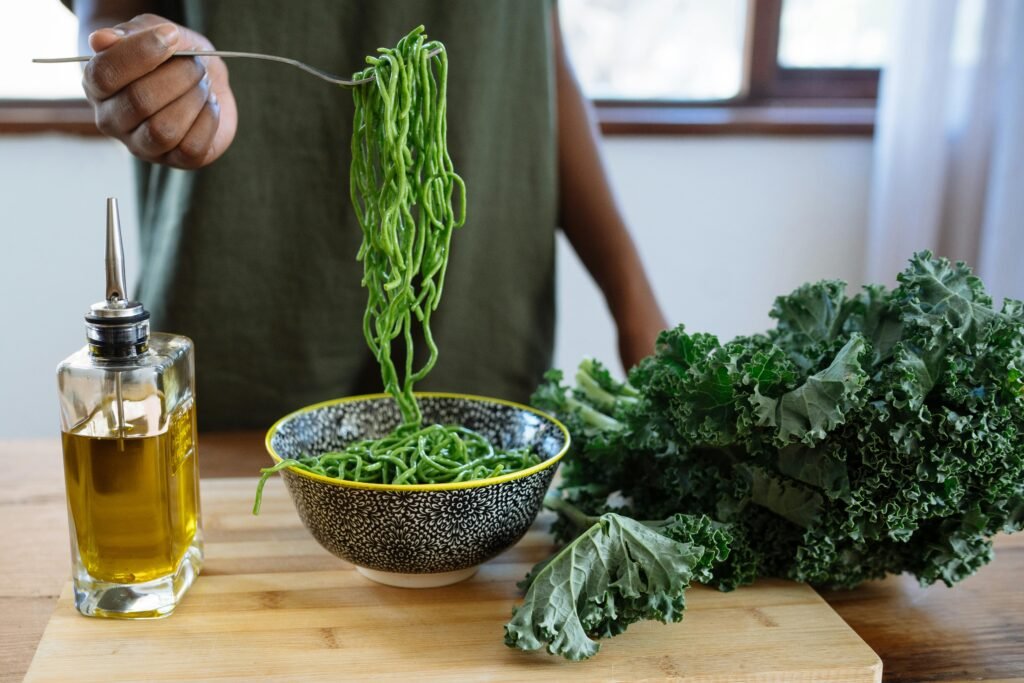
Introduction to Keto for Vegetarians
The ketogenic diet has gained popularity for its effectiveness in weight loss and promoting overall health.
While many associate keto with a meat-heavy regimen, it is entirely possible for vegetarians to follow this diet without compromising their dietary choices.
A well-planned vegetarian keto diet focuses on high-fat, low-carb foods that support energy levels and metabolic health.
The essence of the keto diet lies in shifting your body into a state of ketosis, where it burns fat for fuel instead of carbohydrates.
For vegetarians, this means emphasizing foods like avocados, nuts, seeds, cheese, and low-carb vegetables.
By incorporating these ingredients, vegetarians can create meals that are not only keto-friendly but also delicious and satisfying.
One of the challenges vegetarians face on a keto diet is ensuring they get adequate protein and essential nutrients.
Sources like tofu, tempeh, and eggs can help meet protein needs, while a variety of vegetables and dairy products can provide necessary vitamins and minerals.
Meal planning and creativity are key to making the most out of vegetarian keto-friendly foods.
Additionally, many vegetarian dishes can be modified to fit the keto framework by swapping out high-carb components for low-carb alternatives.
For instance, zucchini noodles can replace traditional pasta, and cauliflower can be used instead of rice.
These small changes can make a big difference in maintaining a low-carb lifestyle.
By focusing on nutrient-dense, plant-based foods that are low in carbohydrates, vegetarians can successfully adhere to a ketogenic diet.
This approach not only supports weight loss but also enhances overall well-being, proving that keto isn’t just for meat-eaters.
Keto-Friendly Ingredients for Vegetarians

Transitioning to a keto diet involves focusing on low-carb, high-fat foods, which can be particularly beneficial for those moving away from a carb-rich diet.
According to Jaime Mass, RDN, “Transitioning from a pasta-heavy diet to one rich in veggies and healthy fats should help someone drop unwanted pounds.”
This shift is important for maintaining a healthy weight.
Common keto-friendly vegetarian ingredients include avocados, nuts, seeds, cheese, tofu, and leafy greens.
Stocking your pantry with these staples ensures you always have the essentials for quick and nutritious meals.
However, vegetarians must be mindful of nutrient deficiencies.
As Jaime Mass notes, vegetarians may already be at risk of lacking vital nutrients like vitamin B12, vitamin D, zinc, and omega-3 fatty acids.
It’s important to monitor your intake of these nutrients while following a keto diet.
To ensure variety and nutritional balance, consider incorporating low-carb vegetables like spinach, kale, and broccoli.
Healthy fats are essential on a keto diet, so include sources like olive oil, coconut oil, and nuts such as almonds and walnuts.
Cheese and other dairy products can also add flavor and richness to your meals while providing essential nutrients.
Tofu and tempeh serve as excellent protein sources and can be used in a variety of dishes.
Another great option is using seeds such as chia and flaxseeds, which are not only low in carbs but also high in fiber and omega-3 fatty acids.
Maintaining a well-rounded vegetarian keto diet involves keeping these ingredients on hand and creatively using them in your daily meals.
This approach not only helps in adhering to keto guidelines but also ensures you receive all the necessary nutrients for optimal health.
Cauliflower Rice Stir-Fry

Cauliflower rice stir-fry is an easy and tasty way to enjoy a low-carb meal.
Start by using fresh or frozen cauliflower rice as your base.
Sauté the cauliflower rice in a pan with olive oil until it becomes tender and slightly golden.
You can add a variety of colorful vegetables to make this dish more nutritious and flavorful. Consider incorporating bell peppers, snap peas, carrots, and broccoli for added crunch and vitamins.
To enhance the flavor, mix in some minced garlic and freshly grated ginger.
A splash of soy sauce or tamari can add a savory depth to the dish. For a hint of spice, you might want to add some red pepper flakes or a dash of sriracha.
For protein, consider adding tofu or tempeh. Sear the tofu or tempeh cubes in a separate pan until they are crispy on the outside, then mix them into the stir-fry. This addition makes the dish more filling and provides essential nutrients.
Garnish the stir-fry with chopped green onions and a sprinkle of sesame seeds for added texture and flavor.
You can also drizzle a little sesame oil over the top for an extra nutty aroma.
The great thing about cauliflower rice stir-fry is its versatility.
Feel free to experiment with different vegetables and seasonings to suit your taste preferences.
It’s a convenient dish that can be prepared in under 30 minutes, making it perfect for busy weeknights.
Zucchini Noodles with Avocado Sauce
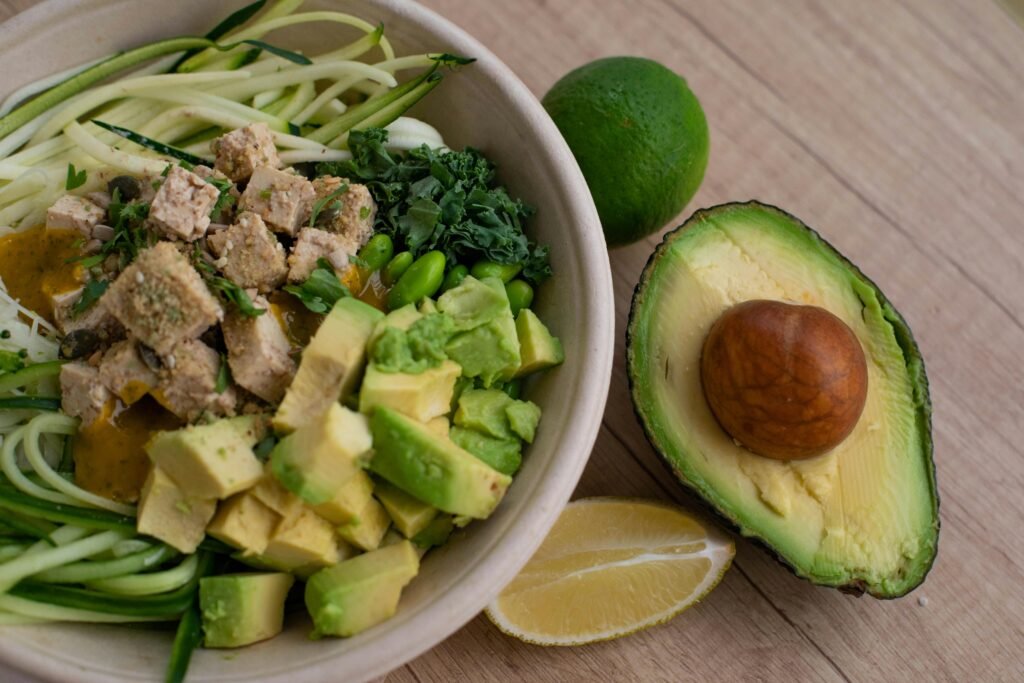
Zucchini noodles, or zoodles, make a fantastic pasta substitute for those on a keto diet.
To prepare the noodles, use a spiralizer to create long, spaghetti-like strands from fresh zucchini.
Lightly sauté the zoodles in a pan with a small amount of olive oil until they are just tender, being careful not to overcook them to avoid a mushy texture.
For the avocado sauce, start by selecting ripe avocados.
In a blender, combine the avocados with fresh lemon juice, minced garlic, and a handful of fresh basil leaves.
Blend until the mixture is smooth and creamy, adding a splash of water or olive oil if needed to achieve the desired consistency.
Season with salt and pepper to taste.
Once the zoodles are ready, toss them in the avocado sauce until they are well coated.
For an added protein boost, incorporate grilled tofu or tempeh cubes.
Simply season the tofu or tempeh with your favorite spices and grill until crispy and golden.
To elevate the dish further, sprinkle some freshly grated Parmesan cheese or nutritional yeast over the top for an extra layer of flavor.
Garnish with cherry tomatoes and a few basil leaves to add a burst of color and freshness.
This dish is not only quick to prepare but also a delightful way to enjoy a creamy, flavorful meal that aligns with keto principles.
The combination of zucchini noodles and avocado sauce offers a satisfying texture and a rich taste that can be enjoyed any time of the year.
Feel free to experiment with additional herbs and spices to tailor the dish to your taste preferences.
Eggplant Lasagna
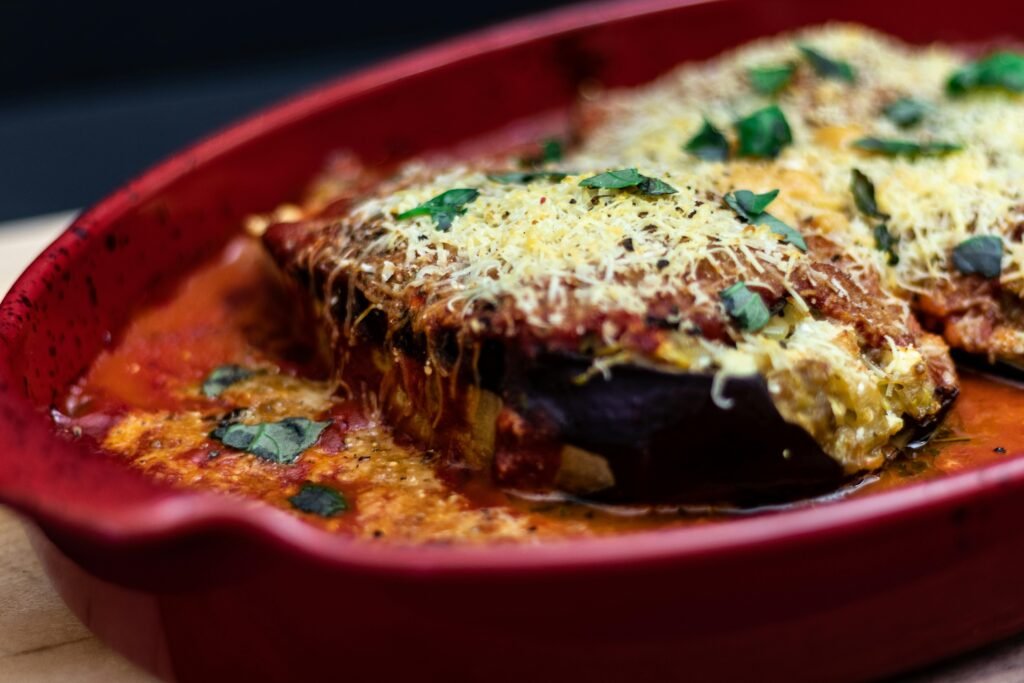
Eggplant lasagna is a delicious and comforting meal that can easily fit into a keto vegetarian diet.
Begin by slicing eggplant lengthwise into thin strips to serve as the “noodles.”
Lay the slices on a baking sheet, sprinkle them with salt, and let them sit for about 15 minutes to draw out excess moisture.
Afterward, blot the slices with a paper towel and roast them in the oven at 400°F until they are slightly tender.
Prepare your marinara sauce using low-carb ingredients, or use a store-bought keto-friendly option.
In a separate bowl, mix ricotta cheese with a beaten egg, minced garlic, and chopped fresh basil for a flavorful filling.
In a baking dish, start by spreading a thin layer of marinara sauce at the bottom.
Layer the roasted eggplant slices over the sauce, followed by a generous layer of the ricotta mixture.
Continue layering with more marinara, eggplant, and ricotta until all the ingredients are used up.
Top the final layer with marinara sauce and sprinkle with shredded mozzarella and Parmesan cheese.
For added texture and nutrients, consider incorporating sautéed spinach, mushrooms, or even bell peppers between the layers.
Cover the dish with aluminum foil and bake at 375°F for about 25 minutes.
Remove the foil and bake for an additional 10-15 minutes, or until the cheese on top is bubbly and golden brown.
Allow the lasagna to cool for a few minutes before slicing and serving.
This dish offers the comforting, rich flavors of traditional lasagna while keeping it keto-friendly and vegetarian.
Spinach and Feta Stuffed Mushrooms

Spinach and feta stuffed mushrooms are a delightful keto-friendly dish that’s both flavorful and nutritious.
Begin by selecting large mushroom caps, such as portobello or large cremini mushrooms, as these provide ample space for the filling.
Gently remove the stems and scoop out any gills to create a cavity for the stuffing.
In a skillet, heat a small amount of olive oil over medium heat.
Add minced garlic and sauté until fragrant. Then, add fresh spinach leaves and cook until wilted.
Transfer the cooked spinach to a mixing bowl and allow it to cool slightly.
Once cooled, combine the spinach with crumbled feta cheese, a touch of cream cheese for added creaminess, and a sprinkle of black pepper.
Mix until well combined.
Preheat your oven to 375°F. Arrange the mushroom caps on a baking sheet lined with parchment paper.
Spoon generous amounts of the spinach and feta mixture into each mushroom cap, pressing down gently to ensure the filling stays in place.
For added flavor, sprinkle a small amount of grated Parmesan cheese on top of each stuffed mushroom.
Bake in the preheated oven for about 20-25 minutes, or until the mushrooms are tender and the filling is golden brown.
The cheese should be melted and slightly bubbly, creating a delicious crust on top.
These stuffed mushrooms make an excellent appetizer or side dish, and their rich, savory taste will be a hit at any meal.
Feel free to customize the filling by adding chopped nuts or herbs like parsley or thyme for extra flavor and texture.
Cheese and Nut Salad
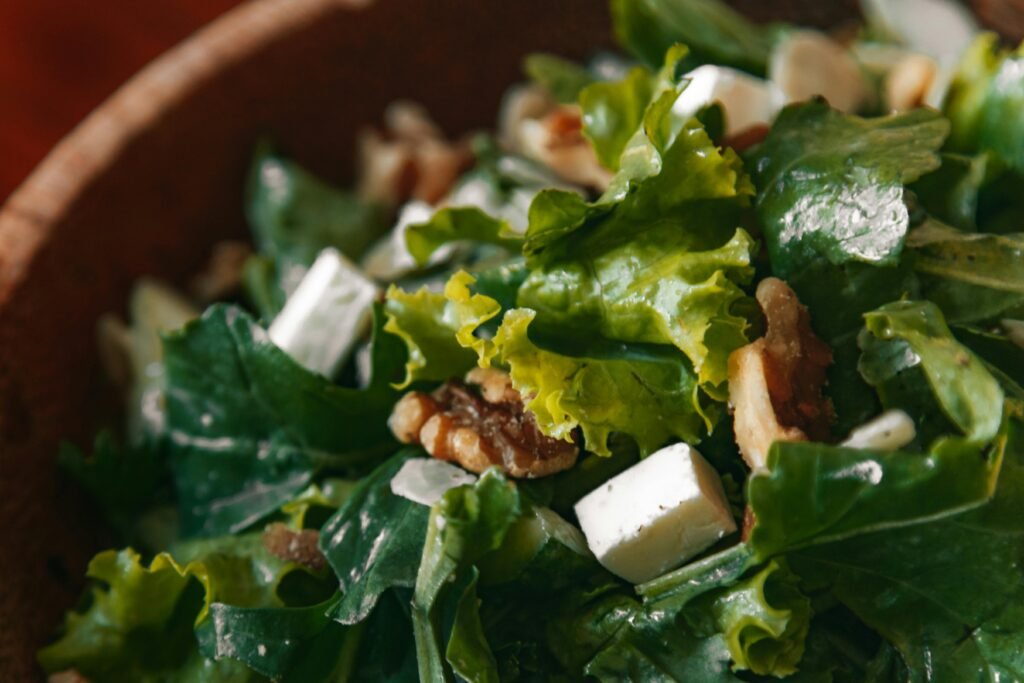
Cheese and nut salad is a simple yet satisfying meal option for those on a keto vegetarian diet.
Start by choosing a mix of leafy greens such as spinach, arugula, or kale, which are low in carbohydrates and high in nutrients.
Add a generous helping of crumbled feta or goat cheese for a creamy texture and tangy flavor.
Both of these cheeses are excellent sources of fat and protein, making them ideal for a keto-friendly salad.
Next, incorporate a variety of nuts to add crunch and additional healthy fats.
Walnuts, almonds, and pecans are all great options.
They provide a good source of omega-3 fatty acids, fiber, and essential minerals.
To boost the flavor, consider lightly toasting the nuts in a dry skillet until they are golden and fragrant.
To assemble the salad, toss the leafy greens with the crumbled cheese and toasted nuts.
Drizzle with a high-quality olive oil, which not only enhances the flavor but also contributes to the healthy fat content.
For added zest, squeeze some fresh lemon juice over the top, and season with salt and pepper to taste.
For a bit of extra flavor and nutrition, you might also consider adding some sliced avocado or a handful of cherry tomatoes.
Both of these ingredients are low in carbs and rich in vitamins and minerals.
Avocado, in particular, is a fantastic source of healthy monounsaturated fats.
This cheese and nut salad is quick to prepare, making it a perfect option for a light lunch or a side dish to accompany a more substantial meal.
Feel free to experiment with different combinations of greens, cheeses, and nuts to keep the salad interesting and enjoyable.
Broccoli Cheddar Soup

Broccoli cheddar soup is a warm, creamy option that’s perfect for a keto vegetarian diet.
Begin by chopping fresh broccoli into small florets.
In a large pot, heat some olive oil over medium heat and sauté chopped onions and minced garlic until they become translucent and fragrant.
Add the broccoli florets and vegetable broth to the pot, bringing the mixture to a boil.
Reduce the heat and let it simmer until the broccoli is tender, about 10-15 minutes.
Once the broccoli is cooked, use an immersion blender to puree the mixture until smooth.
If you don’t have an immersion blender, you can transfer the soup in batches to a regular blender.
Be cautious of hot splashes when blending. Return the pureed soup to the pot and stir in heavy cream for added richness.
Gradually add shredded sharp cheddar cheese, stirring constantly until the cheese is fully melted and the soup is creamy.
Season with salt, pepper, and a pinch of nutmeg for a subtle warmth.
For an extra layer of flavor, you can also add a dash of hot sauce or smoked paprika.
To enhance the texture, consider reserving a handful of broccoli florets and steaming them separately.
Add these whole florets back into the pureed soup for a delightful mix of textures.
Serve the broccoli cheddar soup hot, garnished with additional shredded cheese and a sprinkle of chopped chives or green onions.
This hearty soup is not only delicious but also packed with essential vitamins and minerals.
Portobello Mushroom Burgers

Portobello mushroom burgers are a delightful meat-free option that fits perfectly within a keto vegetarian diet.
Begin by selecting large, fresh Portobello mushroom caps and gently cleaning them with a damp cloth.
Prepare a simple marinade using balsamic vinegar, olive oil, minced garlic, and a pinch of salt and pepper.
Allow the mushrooms to marinate for at least 15-20 minutes to absorb the flavors.
While the mushrooms are marinating, heat a grill or grill pan over medium-high heat.
Once the grill is hot, place the marinated mushrooms cap-side down and grill for about 5-7 minutes per side, or until they become tender and have visible grill marks.
This grilling process brings out a rich, smoky flavor that enhances the overall taste.
For the burger assembly, start with a sturdy lettuce leaf as a base or opt for a low-carb bun if you prefer.
Layer the grilled Portobello mushrooms with keto-friendly toppings such as sliced avocado, tomato, red onion, and a slice of cheese like mozzarella or cheddar.
To add an extra layer of flavor, consider spreading a bit of pesto or a dollop of mayonnaise on the top bun or lettuce leaf.
Experiment with different seasonings and toppings to create your perfect Portobello mushroom burger.
Some tasty options include adding a fried egg, pickles, or a handful of arugula for a peppery bite.
These burgers are not only delicious but also a nutritious and satisfying meal option for any keto vegetarian.
Conclusion and Tips for Success
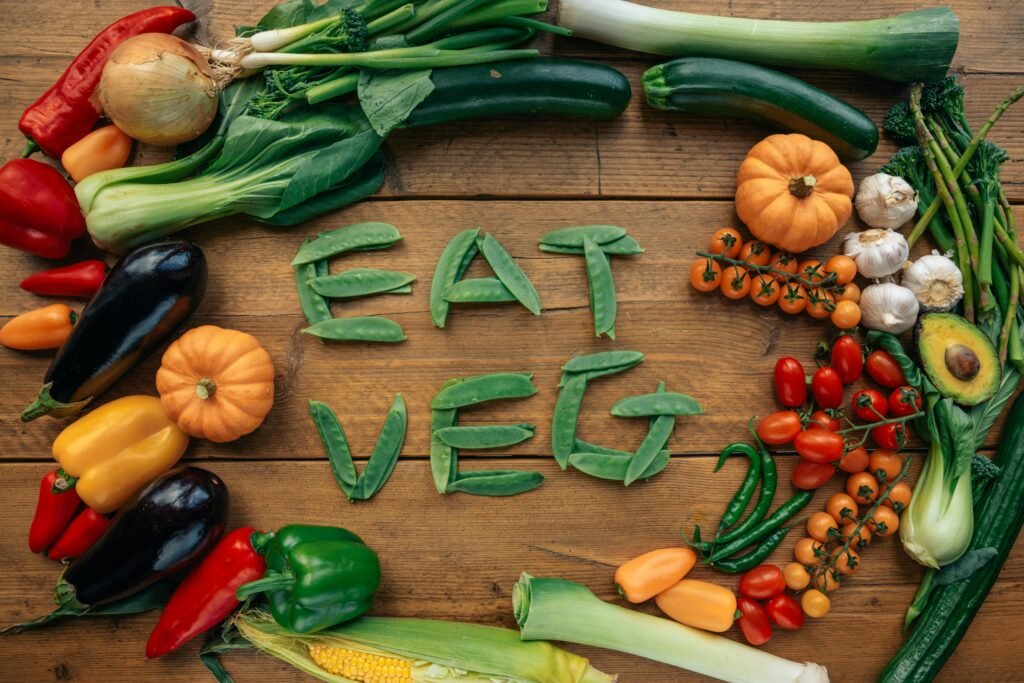
A successful keto vegetarian diet hinges on incorporating a diverse range of ingredients to ensure nutritional balance and variety.
Prioritize nutrient-dense foods like leafy greens, nuts, seeds, and high-quality dairy products to meet your dietary needs.
Regularly incorporate plant-based protein sources such as tofu and tempeh to maintain adequate protein intake.
It’s also beneficial to monitor your nutrient levels, particularly for vitamins B12 and D, zinc, and omega-3 fatty acids, which can be more challenging to obtain on a vegetarian diet.
Planning your meals ahead of time can help you stay on track and avoid high-carb temptations.
Keep your pantry stocked with keto-friendly staples so you’re always prepared to whip up a nutritious meal.
Don’t shy away from experimenting with new recipes and flavors to keep your meals exciting and satisfying. Remember, flexibility and creativity are key to maintaining a sustainable keto vegetarian lifestyle.
Engage with online communities or support groups for additional inspiration and tips.
Sharing your journey with others can provide motivation and new ideas.
Stay committed to your health goals, and you’ll find that a keto vegetarian diet can be both enjoyable and effective.
